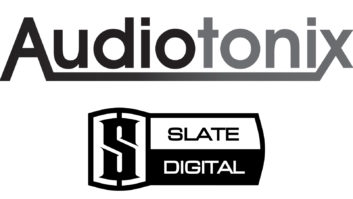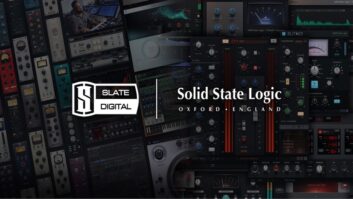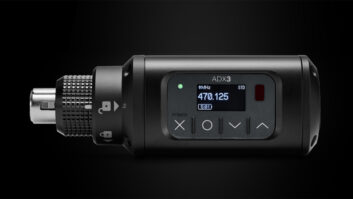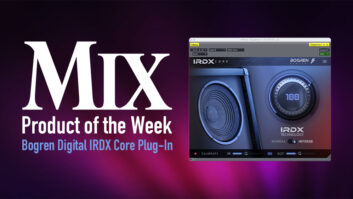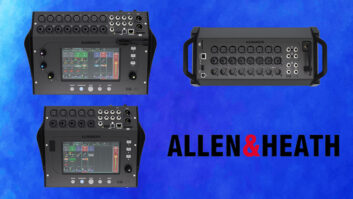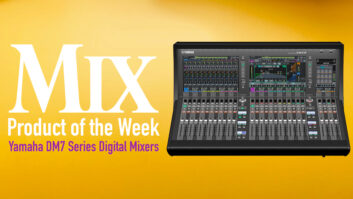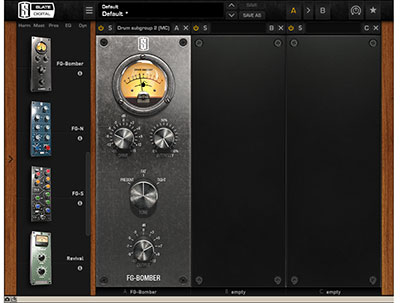
FG-Bomber ($129) is a new module for Slate Digital’s Virtual Mix Rack plug-in (VMR), an effects rack into which you can load up to eight compatible Slate signal-processing modules. Combining digital models of analog transient processing, sustain-enhancing compression and tube saturation into one module, FG-Bomber’s GUI is designed for ease of use—just four controls and a VU meter. Bomber’s intended applications include individual tracks, subgroups and full mixes.
I reviewed FG-Bomber in VMR Version 1.2.0.13 and Digital Performer 9.01, using an 8-core Mac Pro running OS X 10.9.5.
Bombshell
Slate Digital offers the VMR rack shell and one module (the Revival Sonic Enhancement Processor) as a free download. The effects rack (available in AAX, AU, RTAS, VST2 and VST3 formats) also offers compressors, equalizers, the company’s Virtual Console Collection and, of course, FG-Bomber as optional modules, each of which require purchase. Simply drag modules from the browser—located to the left of the rack—into the rack’s empty slots to chain processors in series (see Fig. 1).
Bomber’s continuously variable Drive control is the cornerstone for the module’s operation, yet the operation manual is vague about what processing it induces at its different settings—no doubt to protect trade secrets. Nag that I am, I managed to extract more details from Steven Slate, CEO of Slate Digital. The Drive control adjusts the input gain (±15 dB) applied to a network of processors daisy-chained in series: a transient enhancer, compressor and tube-like saturator. Transient enhancement is produced using harmonics processing instead of envelope shaping, as employed by products such as SPL Transient Designer. The compressor was designed to increase sustain, but it also adds harmonics. The saturation stage kicks in at high Drive levels.
A VU meter shows the input signal’s level after drive is applied. An icon of a fused bomb marks the center point of the meter’s range; this is noted in the operation manual as the sweet spot for most applications, and that’s certainly true for processing drums and percussion. Specifically, the meter’s needle hits the bomb icon at the point where maximum transient enhancement is being applied, creating the greatest increase in attack and impact. If Bomber’s processing sounds too percussive for a particular application, boosting the Drive control further will progressively increase compression and round off transients, while enhancing sustain. Note that even with the Drive control set fully counter-clockwise, some compression is still occurring.
The best way to find the Drive control’s optimal setting is to initially boost Bomber’s Intensity control—a wet-dry balance control—all the way to 100% (passing wet signal only) so you can clearly hear what the processing is doing. Once you’ve set the Drive control for the desired blend of processing, lower the Intensity control to add back dry signal to taste. A little bit of wet signal goes a long way, and you’ll sometimes find yourself using very low Intensity settings.
Bomber’s Tone control—a three-way switch—changes its compressor topology. According to the manual, the Present switch setting “focuses the effect on the mid frequencies” and increases transient attack, sustain and perceived width. The Fat setting also increases transient attack, while reportedly enhancing perceived depth and richness and making the bottom end sound bigger and wider. The Tight setting applies processing more evenly across the audio spectrum than the other two, resulting in increased clarity and punch and tighter lows. A separate Output control adjusts Bomber’s output level ±12 dB.
Target Practice
Using the Fat setting and raising the Drive control so that the meter’s needle hit the bomb icon, Bomber made a subgroup for drums pop. Cranking the Intensity control all the way up, the snares’ rattle and room tone were all but eliminated, making the drums sound very pointy and dry. While the processed subgroup sounded way too extreme when soloed, mixing it in with the original tracks sounded awesome. The drums had noticeably greater impact. Cranking the Drive control all the way up and switching to the Present setting sounded even better, boosting the snare’s sizzle and making the room sound five times larger. Awesome!
I loved what Bomber did for male lead vocals, too. Using the Tight setting, adjusting the Drive control so that signal peaks hit the meter’s bomb icon and setting the Intensity control to 50%, the vocal sounded slightly richer and consonants significantly more intelligible. It sounded like the singer had stepped a foot closer to the mic and was more energized and articulate—perfect for this up-tempo song.
I wasn’t wild about using Bomber on my mix bus, although I can envision it possibly being used on some rock and EDM mixes. While Bomber added rich luster and enhanced clarity to full mixes, and its transient enhancement sounded very natural, its compressor wasn’t transparent enough to add density without audible modulation—even with the Drive control turned all the way down (fully counter-clockwise). For that reason, I’d only be tempted to use it on mix buses for rock, EDM and other productions where light pumping might sound appropriate. I tried using Bomber while mastering an alt-rock mix but felt it didn’t offer enough control to dial in the sound to my satisfaction.
I also didn’t like what Bomber did for electric bass guitar. In order to enhance transients enough to make the track pulse, I had to turn up the Drive control to where the compressor squashed and thinned out the sound slightly. (At -12.7 dB, the Drive control was barely turned up.) I got better results using another transient processor in my arsenal.
Should You Get Bombed?
Bomber’s lack of independent controls for each of its processors makes the perfect setup sometimes difficult or impossible to achieve; you’ll sometimes need to lower the Drive control more than you’d like for one process to prevent adding too much of another. But when Bomber works, it sounds awesome.
Bomber’s only other drawback has to do with the VMR shell itself: It doesn’t provide Undo and Redo buttons. That’s easily tolerated once you hear what Bomber can do for drums and vocals. If you’re looking for something uniquely musical to add to your plug-in arsenal, Bomber is worth the coin.
Michael Cooper is a recording, mix, mastering and post-production engineer and a contributing editor for Mix magazine.
